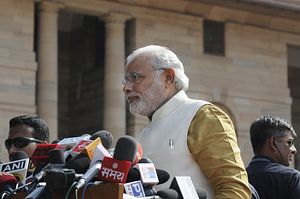On March 25, 2014, members of the Indian and Kyrgyz armed forces completed a two-week joint military exercise in Kyrgyzstan. Involving special forces from each country, including Kyrgstan’s “Scorpions” units, the Kanzhar 2015 exercise focused on the neutralization of armed militant organizations in mountainous areas. While the joint exercise was relatively small, consisting of approximately 100 soldiers, the presence of Indian combat forces on the ground in Central Asia marks an important comeback for India’s hitherto floundering Connect Central Asia policy. Indeed, New Delhi’s poor maneuvering during the latter part of the Manmohan Singh government had left India isolated in Central Asia, a region critical for India’s energy, trade and security needs.
Officially announced by New Delhi in June 2012, India’s Connect Central Asia policy was the formalization of New Delhi’s revamped efforts to offset the grave strategic setback India first suffered in December 2010 with its loss of Tajikistan’s Ayni airbase to Russia. The Ayni airbase had been the key to New Delhi’s plan for expanding India’s strategic footprint in Central Asia. Originally used by the Soviets during the 1980s, the airbase had been abandoned since the 1988-89 withdrawal Soviet troops from Afghanistan. New Delhi contributed technical assistance and $70 million to renovate the airbase between 2003 and 2010. India’s Border Roads Organisation (BRO), directed by the Army Corps of Engineers, extended the main runway to 3,200 meters to accommodate all types of aircraft, built a control tower with state-of-the-art navigational technology, and constructed three hangars capable of housing squadrons of MiG-29 bombers used by the Indian Air Force. Nonetheless, there are no reports of Indian combat aircraft having ever been stationed at the base. Although the BRO began the Ayni renovations in 2004, New Delhi never developed any meaningful leverage with the Tajik government. In December 2010, Tajikistan announced that Russia would be the only country to use the Ayni airbase. Moscow and Dushanbe then began negotiating the terms of their future military cooperation and Russia’s support for Tajik President Emomali Rahmon’s November 2013 re-election bid. India was effectively closed out of Ayni and the embarrassing reversal ushered in a period during which India had virtually no significant defense cooperation in Central Asia.
To bolster its weak position in Central Asia in the wake of its setback in Tajikistan, India convened the first meeting of the India-Central Asia Dialogue in the Kyrgyz capital Bishkek in June 2012. In his keynote address, India’s Minister of External Affairs unveiled New Delhi’s Connect Central Asia Policy. Among its declared objectives for “deep engagement” with the Central Asian republics, New Delhi enumerated the need for strengthened strategic and security cooperation and long-term partnerships in energy development. However, New Delhi continued to struggle to realize these goals.
The ongoing difficulty for India’s Connect Central Asia policy was most poignantly exemplified when Beijing thwarted New Delhi’s attempt to develop a foothold in Central Asian energy by acquiring ConcoPhillips’ 8.4 percent share in Kazakhstan’s massive Kashagan oil field. Although Kazakhstan previously gave indications that it would approve the $5 billion sale of ConocoPhillips’s share to OVL, the international division of India’s Oil and Natural Gas Corporation (ONGC), the Kazakhstani government blocked the transaction and bought ConocoPhillip’s 8.4 percent stake in July 2013. Kazakhstan then turned around in September 2013 and sold an 8.33 percent stake in Kashagan to the Chinese National Petroleum Corporation (CNPC) for an equivalent $5 billion along with CNPC’s agreement to provide $3 billion to cover half the cost of Kashagan’s phase two development.
As discussed recently in The Diplomat, India’s Connect Central Asia policy may soon experience a significant breakthrough in the energy sector with the start of construction on the long stalled Turkmenistan-Afghanistan-Pakistan-India (TAPI) natural gas pipeline. The joint military exercise Indian forces conducted with their counterparts in Kyrgyzstan similarly signals a turnaround for India’s objective to develop strengthened strategic and security cooperation.
The changing fortunes of India’s strategic cooperation in Central Asia is undoubtedly connected to a rising anxiety over Russian hard power as well as a concurrent apprehension over the growing predominance of Chinese economic soft power among the nations of the region. However, it is also the product of India’s more muscular assertion of its national interests in international affairs under Narendra Modi’s government and, in particular, Modi’s deepening strategic partnership with the United States. Five months prior to the Indian-Kyrgyz joint exercises, Kyrgyzstan participated for the first time in the Kazakhstan-NATO joint military exercise known as Steppe Eagle.
Featuring Kazakhstan’s NATO-trained air mobile brigade KAZBRIG, the yearly Steppe Eagle exercises serve to widen the scope of NATO interoperability across the Kazakhstani armed forces and is therefore perhaps the most significant of NATO’s Partnership for Peace programs conducted in Central Asia. Despite the fact Kyrgyzstan has received a $1 billion military aid package from Moscow, Bishkek chose to participate in Steppe Eagle 2014, which ran from September 16 to October 25, 2014. That followed the 2013 training of almost 900 members of Kyrgyz special forces units by the United States. Among those units trained by the U.S. were Kyrgyzstan’s “Scorpions” special forces that participated in the March 2015 joint exercises with India.
India’s decision under Narendra Modi to modify its policy orientation of strategic autonomy and develop closer cooperation with the United States, as well as strong U.S. allies like Japan, enhances New Delhi’s value as a security partner. Should India continue to pursue this new policy direction, the India-Kyrgyzstan joint exercise may be an augur of a greater Indian role in the strategic architecture of Central Asia.
Micha’el Tanchum is a Fellow in the Middle East and Asia Units, Truman Research Institute for the Advancement of Peace, Hebrew University. Dr. Tanchum also teaches in the Departments of Middle Eastern History and East Asian Studies as well as the Faculty of Law at Tel Aviv University.

































